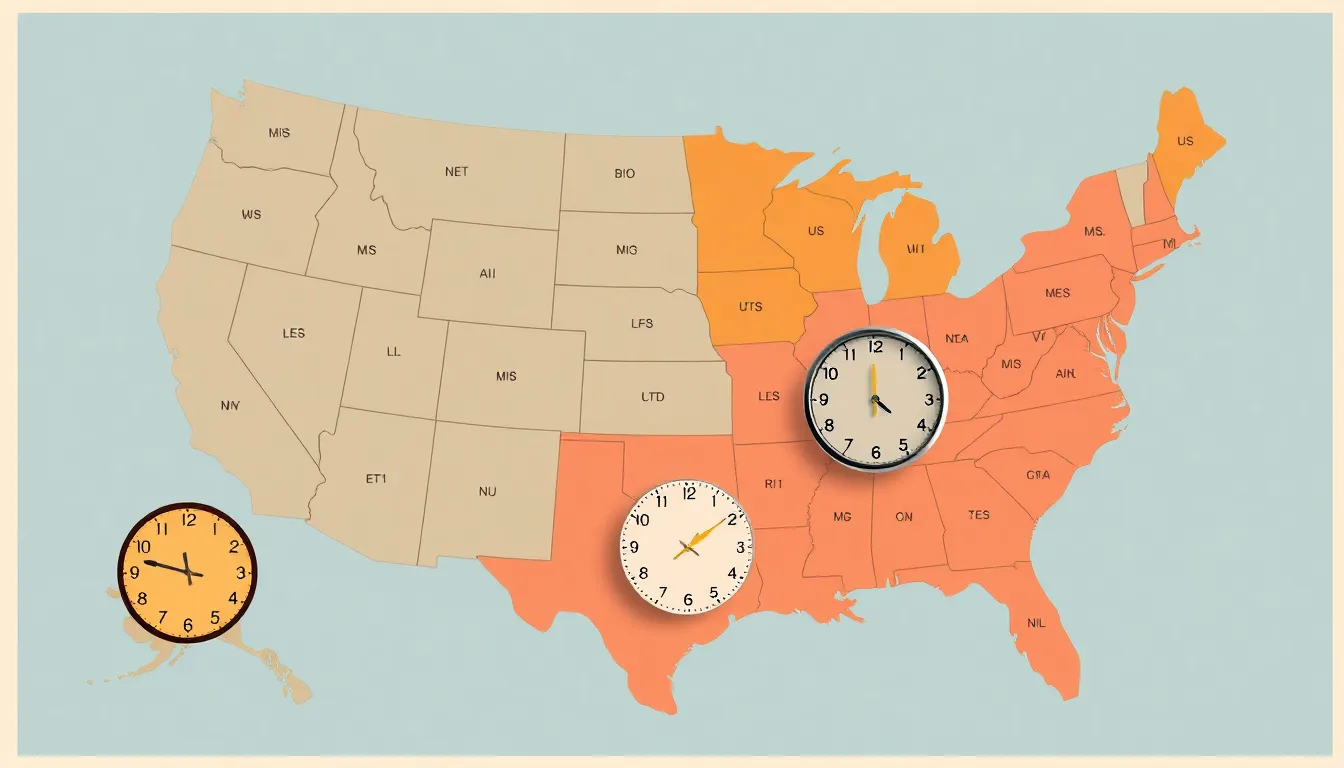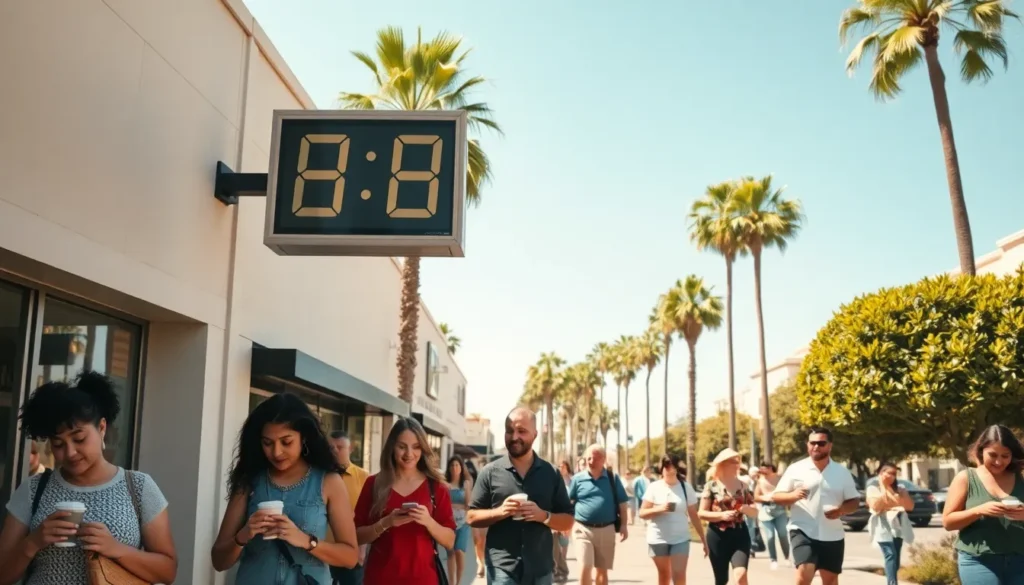Every spring, millions of people spring forward, losing an hour of sleep and gaining a whole lot of confusion. Daylight saving time is that quirky ritual where clocks jump ahead, and coffee becomes everyone’s best friend. But not every state joins the party. Some folks are happily snoozing while others are adjusting their schedules like it’s a game of musical chairs.
So which states are in on the daylight savings fun, and which ones are blissfully untouched by this time-twisting tradition? Whether you’re a fan of longer evenings or just trying to figure out when to call your friends, understanding where daylight saving time applies can save you from some serious scheduling headaches. Let’s dive into the states that embrace this semi-annual time warp and those that prefer to keep things simple.
Table of Contents
ToggleOverview Of Daylight Savings Time
Daylight saving time (DST) involves advancing clocks by one hour during warmer months. Many states participate in this shift, aiming to make better use of daylight during evenings. Clocks spring forward on the second Sunday in March and fall back on the first Sunday in November.
However, not all states observe DST. Arizona and Hawaii are notable exceptions, choosing to adhere to standard time year-round. A few territories, such as Puerto Rico and the U.S. Virgin Islands, also opt out of this tradition. States considering permanent standard time cite reasons such as health impacts and convenience.
Adjustments can cause confusion, especially for businesses and residents in neighboring states. For example, a state that observes DST will experience time differences with a neighboring state that does not during certain months.
Understanding which states participate supports better scheduling for travel, work, and events. The current trend shows a growing number of states proposing legislation to eliminate the clock changes altogether. Popular discussions explore alternatives to DST, including the adoption of permanent daylight saving time or standard time year-round.
Legislative proposals vary. Some states aim to remain in daylight saving time permanently, while others discuss staying on standard time. Public interest in this subject continues to rise as the implications of time shifts affect everyday life.
States That Observe Daylight Savings

Daylight saving time (DST) is observed by many states across the United States. Understanding which states fully participate is crucial for scheduling events.
States That Fully Participate
Most states that adopt DST adjust their clocks every year. These states include California, Texas, New York, Florida, and Illinois. Clocks spring forward in March and fall back in November. Participants typically experience the full range of benefits associated with DST. Approximately 48 states engage in this time change, emphasizing its widespread acceptance nationwide.
States With Partial Participation
A few states exhibit partial participation in daylight saving time. Indiana and parts of Arizona present unique cases. In Indiana, some counties observe DST while others do not. Arizona, except for the Navajo Nation, remains exempt from the time change altogether. This variance can create confusion for residents and visitors alike. Understanding these exceptions helps navigate the scheduling challenges that arise from differing time observance.
States That Do Not Observe Daylight Savings
Arizona and Hawaii are the primary states that do not observe daylight saving time. In Arizona, the majority of the state remains on standard time year-round, excluding the Navajo Nation, which observes DST. This practice minimizes confusion related to time changes, especially in areas close to states that do participate.
Additionally, several U.S. territories also do not engage in DST. Puerto Rico, Guam, the U.S. Virgin Islands, and American Samoa maintain standard time throughout the year. Their decision to opt out stems from a preference for consistency in scheduling and daily routines.
The choice to disregard daylight saving reflects the priorities and lifestyles of residents in these regions. In places like Arizona, the lack of a time change accommodates the state’s warm climate, ensuring that daylight doesn’t disrupt daily activities. Meanwhile, Hawaii’s geographic location and tropical climate make the seasonality of daylight savings less impactful.
With discussions around potential changes to DST gaining traction, some states may consider joining the list of non-observers. Recent trends show a growing interest in eliminating the clock changes altogether. As a result, legislators examine the implications for both permanent daylight saving time and standard time.
Understanding states that do not observe DST helps individuals navigate scheduling discrepancies and make informed decisions when traveling or planning events. Complications from time changes can lead to confusion; being aware of exceptions can alleviate these challenges significantly.
The Impact Of Daylight Savings Time
Daylight saving time (DST) significantly influences daily activities and routines. Energy consumption often declines during the warmer months, as extended daylight hours reduce reliance on artificial lighting. However, studies suggest that this energy savings may be marginal and inconsistent across different regions.
Health implications arise due to the abrupt time change. Sleep disruptions frequently occur, leading to increased incidents of fatigue and reduced productivity. Some research indicates a rise in heart attack risks in the days following the clock adjustment.
Economic effects also play a role. Retail businesses frequently report increased sales during DST due to extended hours of daylight. Conversely, sectors that rely heavily on scheduling, such as transportation and technology, grapple with the complications that DST introduces.
Localized confusion often affects residents, especially in states that partially participate in DST. For instance, Indiana’s diverse observance creates scheduling challenges for its residents. Areas in states like Arizona see similar confusion near time-observing borders, resulting in misunderstandings about appointments and travel.
Public interest in the implications of DST continues to grow. Several states have introduced legislation aimed at adopting permanent daylight saving time or standard time year-round. Ongoing discussions reveal that many individuals seek a more consistent approach to time management. Awareness of the impact of DST enables better decision-making for travel and event planning, especially when accounting for differing observance policies among states.
Understanding which states observe daylight saving time is essential for effective scheduling and planning. With most states participating and a few notable exceptions like Arizona and Hawaii, the variations can lead to confusion for residents and travelers alike. As discussions around potential changes to DST continue to grow, staying informed about these time shifts is crucial. This knowledge not only aids in daily activities but also helps mitigate the health and economic impacts associated with the clock changes. As more states consider legislation to alter or eliminate DST, the landscape of timekeeping may evolve, making it even more important to keep track of these developments.





